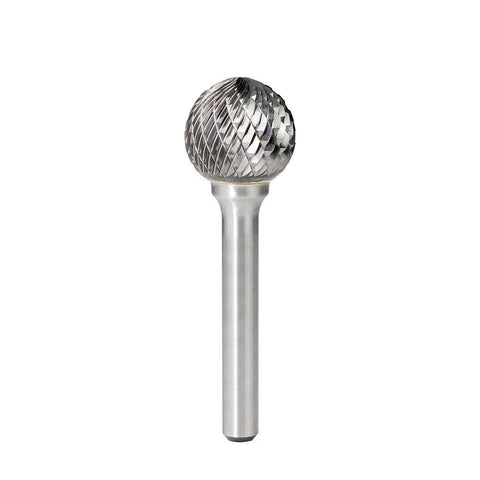Precision and Power: How to Use Carbide Burrs Effectively
Carbide burrs are versatile, powerful tools that have become essential in many industries, from metalworking and automotive repair to woodworking and crafting. Known for their strength and durability, carbide burrs can handle a variety of tasks, such as cutting, grinding, shaping, and deburring tough materials. Using them correctly not only improves the quality of your work but also ensures the longevity of the burrs themselves. Understanding how to use carbide burrs effectively is key to achieving precise, efficient results, whether you're a professional or a hobbyist.
Selecting the right burr for the job is the first step in maximizing the tool's efficiency. Carbide burrs come in different shapes and sizes, each designed for specific tasks. Cylindrical burrs are ideal for grinding flat surfaces or cleaning up welds, while cone-shaped burrs are better suited for working in tight corners or creating precise details. For deburring or enlarging holes, you might choose a spherical or oval-shaped burr. Additionally, it's important to match the burr to the material you're working on. Coarse-toothed burrs work best for rapid material removal, while fine-toothed burrs offer smoother, more detailed finishes.
Using the correct speed is essential to get the best performance out of carbide burrs. These tools are designed to work at high speeds, typically between 25,000 and 35,000 RPM. However, running them at too high a speed on harder materials can lead to overheating, which dulls the burr and can damage the material. For metals like steel or cast iron, slower speeds help maintain control and reduce heat buildup. Softer materials like aluminum or wood can handle faster speeds, allowing for quicker cuts. Adjusting the speed based on the material ensures that the burr operates efficiently without unnecessary wear.
When using carbide burrs, control is critical to achieving clean, precise results. Always use two hands when operating the tool. One hand should guide the tool while the other provides stability. This prevents the burr from skipping or jumping across the material, which can cause uneven cuts or accidental damage. Apply light, even pressure, letting the burr do the work. Pushing too hard can cause the burr to dig into the material, leading to gouges or an uneven surface. The key is to maintain a steady, controlled motion for consistent and accurate results.
Safety is a top priority when working with high-speed tools like carbide burrs. The sharp cutting edges and fast rotation can create flying debris, making safety glasses essential. Gloves are recommended to protect your hands from sharp edges and hot materials, especially during prolonged use. It's also important to wear a dust mask, particularly when working with materials that produce fine particles, such as wood, plastics, or metals. Proper ventilation in your workspace can help reduce the risk of inhaling harmful dust, contributing to a safer, cleaner environment.
Keeping the burr in motion during use is a fundamental technique for achieving smooth, professional results. Stopping in one spot can cause overheating, burn marks, or uneven cuts. To prevent this, move the burr continuously in a sweeping or circular motion, depending on the task at hand. For large areas, using longer strokes helps cover more ground and creates a uniform surface. When working on detailed sections or corners, slower, more deliberate movements will give you the control needed for precision. Whether you're shaping, grinding, or engraving, constant movement ensures that the burr delivers a clean, consistent finish.
For detailed work, choosing the right burr size is crucial. Smaller burrs allow for more intricate cuts and finer control, while larger burrs are better for removing material quickly. Switching between burrs of different sizes and shapes can be beneficial during a project, especially when transitioning from rough shaping to fine finishing. Smaller, pointed burrs are perfect for engraving or delicate detailing, while larger burrs are ideal for rapid material removal in the early stages of a project. Having a variety of burrs on hand lets you adapt to different tasks, enhancing the overall quality of your work.
Proper maintenance of carbide burrs is key to extending their lifespan and keeping them sharp. Regular cleaning is important to prevent debris from clogging the cutting edges, especially when working with softer metals or wood. For metalworking, applying a lubricant or cutting fluid can reduce friction and heat buildup, helping to preserve the sharpness of the burr and ensuring a smooth, precise cut. Periodically inspecting the burrs for signs of wear, such as dulling or chipping, allows you to replace them before they negatively affect your work. Storing burrs properly, in a dedicated case or organizer, protects them from accidental damage and ensures they're ready for the next job.
Carbide burrs offer incredible versatility across a wide range of applications, but using them effectively requires attention to detail. Selecting the right burr for the material and task, adjusting the speed, and maintaining control are all essential for achieving professional results. By keeping the tool moving, practicing safety precautions, and maintaining the burrs regularly, you can ensure that these powerful tools perform at their best. Whether you're working on metal, wood, or other materials, carbide burrs provide the precision and durability needed to tackle even the toughest jobs with confidence.
